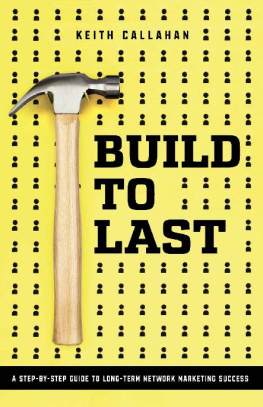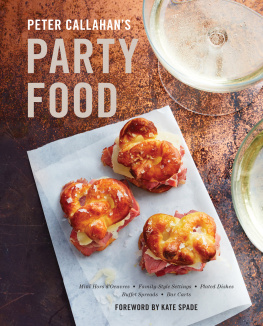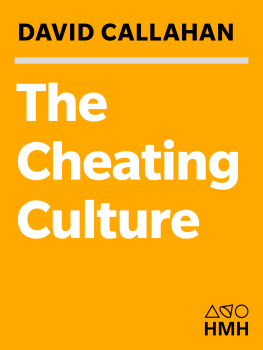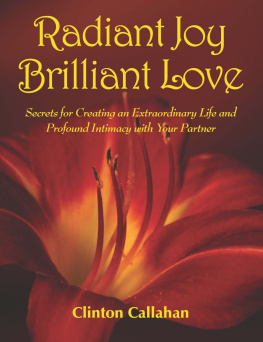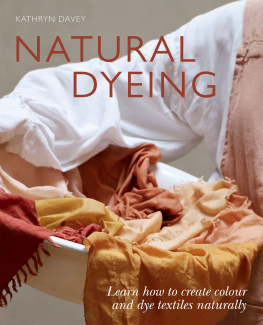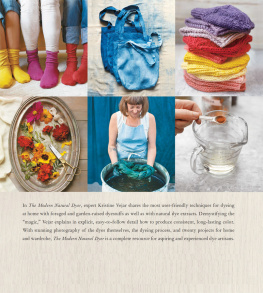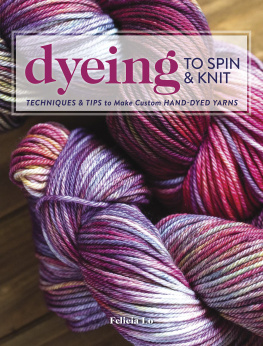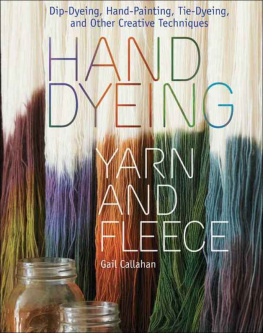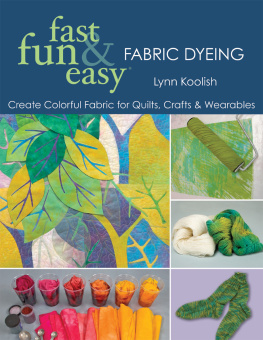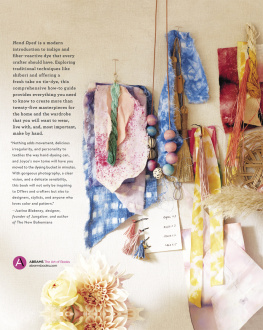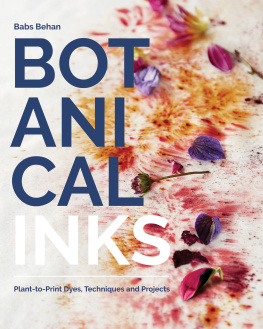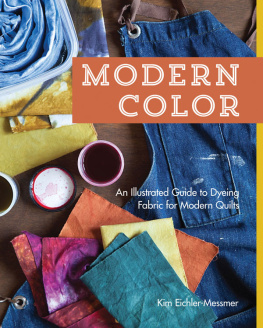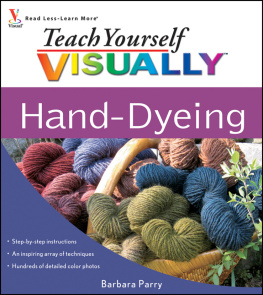HAND DYEING
YARN AND FLEECE

Dip-Dyeing, Hand-Painting, Tie-Dyeing, and Other Creative Techniques
GAIL CALLAHAN
PHOTOGRAPHY BY JOHN POLAK

The mission of Storey Publishing is to serve our customers by
publishing practical information that encourages
personal independence in harmony with the environment.
Edited by Gwen Steege
Art direction and book design by Mary Winkelman Velgos
Photography by John Polak Photography,
except swatches on pages 15963 by Mars Vilaubi
Photo styling by Lisa Newman
Charts by Leslie Anne Charles, LAC Design
Indexed by Nancy D. Wood
2010 by Gail Callahan
All rights reserved. No part of this book may be reproduced without written permission from the publisher, except by a reviewer who may quote brief passages or reproduce illustrations in a review with appropriate credits; nor may any part of this book be reproduced, stored in a retrieval system, or transmitted in any form or by any means electronic, mechanical, photocopying, recording, or other without written permission from the publisher.
The information in this book is true and complete to the best of our knowledge. All recommendations are made without guarantee on the part of the author or Storey Publishing. The author and publisher disclaim any liability in connection with the use of this information.
Storey books are available for special premium and promotional uses and for customized editions. For further information, please call 1-800-793-9396.
Storey Publishing
210 MASS MoCA Way
North Adams, MA 01247
www.storey.com
Printed in China by Dai Nippon Printing
10 9 8 7 6 5 4 3 2 1
Library of Congress Cataloging-in-Publication Data
Callahan, Gail.
Hand dyeing yarn and fleece / by Gail Callahan.
p. cm.
Includes index.
ISBN 978-1-60342-468-4 (hardcover with concealed wire-o : alk. paper)
1. Dyes and dyeingTextile fibers. 2. Yarn. 3. Wool. I. Title.
TT853.C35 2010
746.6041dc22
2009028676
To my most important creations,
Ross, Casey, and Tim, and to
my loving husband, Bill,
for everything.
CONTENTS

A VERY REASONABLE CRAFT

Of the many reasons for dyeing my own yarns, what first dragged me kicking and screaming to dyeing was need. The lovely yarn I wanted to use for a weaving project was available only in white, but I wanted color. With some trepidation, I chose some green and blue dyes, partly because I love these colors and partly because I knew that if they were either accidentally or intentionally mixed together during the dye process or during the weaving, I couldnt go wrong. And it was true! With this success behind me, the world of dyeing possibilities opened endlessly before me, and it continues to inspire and tempt me on.
Need isnt the only reason and perhaps not the most important one to dye your own custom colors. I strongly believe that the more you are part of the creative process, the more invested you become in any project you undertake. A recent survey confirmed that people whove taken part in some way in creating their own yarn are more likely to complete their projects than those who did not, whether theyve raised the sheep, spun the fiber, and/or dyed the yarn. Unfortunately, I cant have sheep (although I do sometimes fantasize about having pygmy sheep that could be domesticated!). However, I learned to spin because, as I began writing this book, I wanted to understand what happens to color during the spinning process. Like my first dyeing efforts, I tackled spinning out of necessity! For some dyeing initiates, however, with no compelling reasons to dye, curiosity is enough to spark their interest.
Some reasons to begin dyeing will quickly become apparent if you just examine your stash. If youre like many of us, some of your yarns sit and collect dust because you no longer like their colors. You may have bought a skein at a great sale or inherited it from a friends stash or have it left over from some long-ago project. These are all candidates for dyeing experiments. And even though this book focuses on protein fibers (see ), dont be deterred from dyeing fiber blends, including wools blended with synthetics. The protein fibers will accept the dyes beautifully, and youll often get surprisingly lovely results on the remaining fibers.
Reason to Dye #1: Beautiful Fiber, Ugly Color
Unless the yarn is exceptionally dark, a dye bath can work wonders on a to-die-for fiber, transforming an ugly duckling into something very special. New life for old duds!
Reason to Dye #2: Specific Color
Its rare for a brand of yarn or fiber to carry enough colors to satisfy everyones color needs. For instance, to create their intricate pictorial pieces, rug hookers and tapestry weavers require just the right shades and seldom can find enough colors to meet their needs.
Reason to Dye #3: Economy
A complicated project that requires many colors, such as stranded or intarsia knitting, can be exorbitantly expensive if you have to buy a skein for every color you want, even if you need only a small amount of many of the colors. If you dye your own yarns, however, you can wind off small lengths from a single skein and dye each a different shade in just the amounts you need. No need to limit the creative possibilities because you feel you need to stick to fewer colors than youd really like to have.
Reason to Dye #4: Reuse and Recycle
Apart from your stash of yarns, consider woven, crocheted, or knit fabrics, either tucked away in the back of your closet or inexpensively available at thrift stores. Any of these can be dyed as is, then unraveled and reknit, or you may want to unravel the yarn before redyeing it.
Reason to Dye #5: Because You Want To
Why not? Become your own colorist. Personalize your work and expand your creative potential!
The Big Three: Fiber, Color, Heat
Youll learn much more about the materials and techniques you can explore in the pages that follow, but let me assure you that to dye successfully, what you always need and all you need are fiber, color, and heat. Ill remind you of this simple trio many times throughout the book. Of course, each member of the trio contains many possibilities.
Fiber. Although in this book were discussing only animal (protein) fiber, that fiber comes from a variety of animals and is processed in many different forms, including unspun fleece (raw locks, batts, top, or roving), yarn, and cloth.
Color. Among the infinite number of colors to choose from, you can use dyes in the form of grocery-store drink mixes, food coloring, and commercial dyes.
Heat. Heat sources used to set the dyes might be a microwave or regular oven, a slow cooker, a stovetop, an electric frying pan, or even a solar oven.
These form the basis for all dyeing. I like to think of fiber and heat as finite resources because there are just so many sources of each, while color is infinite because the combinations are limitless.


